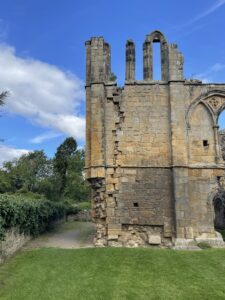Last Sunday’s wander through Richmondshire brought us to Easby Abbey, a place where ruin and landscape merge into a single, haunting picture beside the River Swale. Artists and antiquaries have long been drawn to it—J. M. W. Turner included—captivated by its quiet grandeur.

The abbey was founded around 1152–1155 by Roald, constable of Richmond Castle, for the Premonstratensian canons, known as the “White Canons” for their undyed robes. Unlike purely contemplative orders, they combined a communal religious life with pastoral work and preaching. The site may already have been sacred ground; before the Norman Conquest it likely held a Saxon ‘minster’ church served by priests for the surrounding parishes.
In the Middle Ages, Easby flourished. Patronage from local lords, especially the Scrope family in the late fourteenth century, brought wealth, land, and ambitious building projects. For a Premonstratensian house, Easby remains unusually complete: the abbey church of St Agatha stands largely as it did in the late twelfth century, with cloister ranges and substantial stretches of the east and south ranges still in place. The gatehouse, barn, and mill mark the edges of the precinct, while nearby earthworks reveal terraces and water systems that once sustained the community.
Its end came in the reign of Henry VIII. In 1536, Easby aligned itself with the Pilgrimage of Grace, a northern rising against the King’s break with Rome. The response was swift and brutal. The royal order read: “At … St Agatha [Easby] and such places as have made resistance … you shall without pity or circumstance cause the monks to be tied up without delay.” “Tied up” here meant hanged. What actually befell the canons is unrecorded.
Local lore adds a final flourish: a tunnel, they say, runs from the Abbey to Richmond Castle, a secret refuge in times of Scottish raids.

Leave a Reply